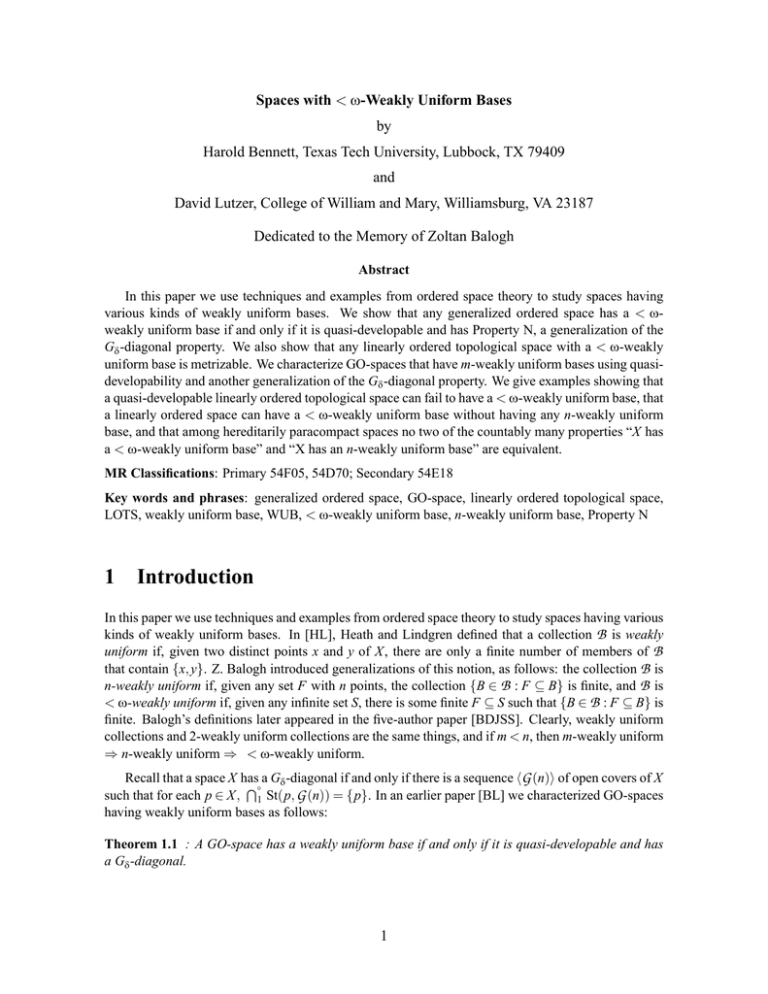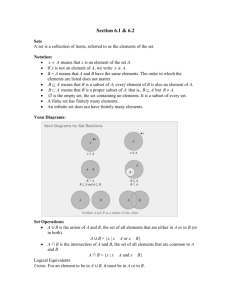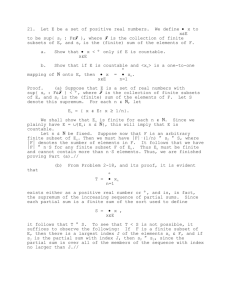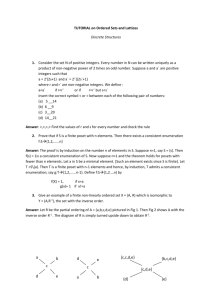Spaces with -Weakly Uniform Bases ω by
advertisement

Spaces with < ω-Weakly Uniform Bases
by
Harold Bennett, Texas Tech University, Lubbock, TX 79409
and
David Lutzer, College of William and Mary, Williamsburg, VA 23187
Dedicated to the Memory of Zoltan Balogh
Abstract
In this paper we use techniques and examples from ordered space theory to study spaces having
various kinds of weakly uniform bases. We show that any generalized ordered space has a < ωweakly uniform base if and only if it is quasi-developable and has Property N, a generalization of the
Gδ -diagonal property. We also show that any linearly ordered topological space with a < ω-weakly
uniform base is metrizable. We characterize GO-spaces that have m-weakly uniform bases using quasidevelopability and another generalization of the Gδ -diagonal property. We give examples showing that
a quasi-developable linearly ordered topological space can fail to have a < ω-weakly uniform base, that
a linearly ordered space can have a < ω-weakly uniform base without having any n-weakly uniform
base, and that among hereditarily paracompact spaces no two of the countably many properties “X has
a < ω-weakly uniform base” and “X has an n-weakly uniform base” are equivalent.
MR Classifications: Primary 54F05, 54D70; Secondary 54E18
Key words and phrases: generalized ordered space, GO-space, linearly ordered topological space,
LOTS, weakly uniform base, WUB, < ω-weakly uniform base, n-weakly uniform base, Property N
1
Introduction
In this paper we use techniques and examples from ordered space theory to study spaces having various
kinds of weakly uniform bases. In [HL], Heath and Lindgren defined that a collection B is weakly
uniform if, given two distinct points x and y of X, there are only a finite number of members of B
that contain {x, y}. Z. Balogh introduced generalizations of this notion, as follows: the collection B is
n-weakly uniform if, given any set F with n points, the collection {B ∈ B : F ⊆ B} is finite, and B is
< ω-weakly uniform if, given any infinite set S, there is some finite F ⊆ S such that {B ∈ B : F ⊆ B} is
finite. Balogh’s definitions later appeared in the five-author paper [BDJSS]. Clearly, weakly uniform
collections and 2-weakly uniform collections are the same things, and if m < n, then m-weakly uniform
⇒ n-weakly uniform ⇒ < ω-weakly uniform.
Recall that a space X has a Gδ -diagonal if and only if there is a sequence hG (n)i of open covers of X
T
such that for each p ∈ X, ∞
1 St(p, G (n)) = {p}. In an earlier paper [BL] we characterized GO-spaces
having weakly uniform bases as follows:
Theorem 1.1 : A GO-space has a weakly uniform base if and only if it is quasi-developable and has
a Gδ -diagonal.
1
In this paper we generalize that result by making use of a property related to the Gδ -diagonal covering
condition above. The new property is called Property N, where we say that X has Property N if there
is a sequence hG (n)i of open covers of X such that for any infinite set S ⊆ X there is a finite set F ⊆ S,
a point p ∈ F, and an integer n such that F 6⊆ St(p, G (n)). We prove:
Theorem 1.2 : A GO-space X has a < ω-weakly uniform base if and only if X is quasi-developable
and has Property N.
Heath and Lindgren originally observed [HL] that any LOTS with a weakly uniform base must be
metrizable. As a corollary to Theorem 1.2 we will strengthen the Heath-Lindgren result to
Corollary 1.3 A LOTS X has a < ω-weakly uniform base if and only if X is metrizable.
Finally, we characterize GO-spaces with m-weakly uniform bases as being those quasi-developable
T
GO-spaces that have open covers G (n) for n ≥ 1 such that for each p ∈ X, the set {St(p, G (n)) : n ≥ 1}
has fewer than m points.
Recall that a generalized ordered space (GO-space) is a triple (X, τ, <) where < is a linear ordering
of X and where τ is a Hausdorff topology on X that has a base of order-convex sets. In case τ is the
open interval topology of the ordering <, then we say that (X, τ, <) is a linearly ordered topological
space (LOTS). It is well-known that the class of GO-spaces coincides with the class of spaces that
embed topologically in a LOTS.
At several points in the next section, we deal with a subset Y of a linearly ordered set X and will
need to use relatively convex subsets of Y , i.e. subsets S ⊆ Y such that if y1 < y2 are points of Y that
belong to S, then [y1 , y2 ] ∩Y ⊆ S.
Throughout this paper we reserve the symbols R, Q, and P for the usual sets of real, rational, and
irrational numbers, and the set of all integers (positive and negative) is denoted by Z.
We thank the referee of our paper for valuable comments that signicantly improved our results.
2
GO-spaces with < ω-weakly uniform bases
Lemma 2.1 Let X be a GO-space with a < ω-weakly uniform base. Then:
a) X has a < ω-weakly uniform base whose members are convex sets;
b) X is first-countable;
c) X is paracompact.
Proof: To prove a), let B be any < ω-weakly uniform base for X. Let C be the family of all convex
components of members of B . Then C is a base for X and is also < ω-weakly uniform. To prove b)
we consider any p ∈ X. If p is isolated, there is nothing to prove, so either every neighborhood of p
contains points below p, or every neighborhood of p contains points above p (or both). In the first case,
compute κ = cf( ] ←, p[ ). If κ ≥ ω1 then we can find an infinite sequence Cn ∈ C of distinct members
of C and a point q < p such that the infinite set ]q, p[ is a subset of each set Cn , contradicting that C
is a < ω-weakly uniform collection. In the second case, a similar argument shows that the set ]p, → [
has countable coinitiality. Therefore, X is first countable at p.
2
To prove c), recall that if X is not paracompact then there is a stationary subset S of some regular
uncountable cardinal that embeds as a closed subspace of X [EL]. Because the existence of a < ωweakly uniform base is hereditary, the space S has a < ω-weakly uniform base C and we may assume
that members of C are convex sets. Let T be the set of non-isolated points of the space S. Then T is
also a stationary set, and for each λ ∈ T there is a set Cλ ∈ C with λ ∈ Cλ ⊆ S ∩ [0, λ]. Choose α(λ) < λ
such that ]α(λ), λ] ∩ S ⊆ Cλ . Then f (λ) = α(λ) is a regressive function, so there is some β and some
stationary set U ⊆ T such that f (λ) = β for each λ ∈ U. Let γ be the first limit point of S that is larger
than β + ω. But then the infinite set ]β, γ[ ∩ S is a subset of each of the uncountably many sets Cλ
for λ ∈ U ∩ ]γ, → [ ∩ T , and that is impossible because C is < ω-weakly uniform. Hence X must be
paracompact. 2
Recall that a space is quasi-developable if it has a sequence hG (n)i of collections of open sets such
that if V is open and p ∈ V then for some n we have p ∈ St(p, G (n)) ⊆ V . It is known that for GOspaces, quasi-developability is equivalent to the existence of s σ-disjoint base. [B1] [L]. The following
lemma is easily proved.
Lemma 2.2 : Suppose X is a first-countable GO-space. If X = {X(n) : n ≥ 1} where each X(n) is
quasi-developable in its subspace topology, then X is quasi-developable.
S
Property N, a generalization of the well-known Gδ -diagonal covering property, was introduced in
the previous section.
Proposition 2.3 If a GO-space X has a < ω-weakly uniform base then X is quasi-developable and has
Property N.
Proof: Suppose that X has a < ω-weakly uniform base B . Lemma 2.1 shows that X is paracompact
and that we may assume that members of B are convex.
First we show that X is quasi-developable. Let M be the union of all open, metrizable subspaces
of X. Because X is hereditarily paracompact, M is metrizable. Let Y = X − M. Observe that it cannot
happen that Y contains points y1 < y2 such that ]y1 , y2 [ ∩Y is finite and non-empty because, X being
first-countable, that would force ]y1 , y2 [ ⊆ M. However, it might happen that Y has consecutive points,
/ Let L be the set of all points y1 ∈ Y such that for some
i.e., points y1 < y2 with ]y1 , y2 [ ∩ Y = 0.
/ and let R be the set of all points y2 ∈ Y such that for some
y2 ∈ Y ∩ ]y1 , → [, the set ]y1 , y2 [ ∩Y = 0,
/ Let Y2 = Y − L and Y1 = Y − R. Then X = M ∪Y1 ∪Y2 .
y1 ∈ Y ∩ ] ←, y2 [ the set ]y1 , y2 [ ∩Y = 0.
Consider the subspace Y1 . It inherits a < ω-weakly uniform base from X and therefore has a base
D of relatively open, relatively convex subsets that is < ω-weakly uniform. Let a, b be distinct points
of Y1 . Without loss of generality, we may suppose a < b. The key property of Y1 is that the set Y1 ∩ [a, b]
must be infinite. Choose a finite set F ⊆ [a, b] ∩ Y1 such that only a finite number of members of D
contain F. But by relative convexity, any member of D that contains the points a and b must contain
all of F. Hence only a finite number of members of D can contain both a and b, and therefore D is a
weakly uniform base for Y1 . Then by Theorem 1.1, the subspace Y1 is quasi-developable. Similarly, Y2
is also quasi-developable. Because X = M ∪ Y1 ∪ Y2 , we may apply Lemma 2.2 to conclude that X is
quasi-developable.
Second we show that X has Property N. Let I = {{p} : {p} ∈ B } and let
B (n) = {∩ni=1 Bi : the sets Bi are distinct members of B }.
3
Let G (1) = B . Given the open cover G (n) for any n ≥ 1, let H (n) be a star-refinement of G (n) and let
G (n + 1) = I ∪ {C ∈ B (n + 1) : C is a subset of some member of H (n)}.
Because any non-isolated point of X belongs to infinitely many members of B , G (n + 1) is an open
cover of X.
Now suppose that S is any infinite subset of X. Because B is < ω-weakly uniform, there is a finite
subset F ⊆ S such that BF = {B ∈ B : F ⊆ B} is finite, and we may assume that F has at least two
points. Let k = |BF | and let n = k + 2. Let p be any point of F and for contradiction suppose that
F ⊆ St(p, G (n)). Then F ⊆ St(p, H (n)) so that, because H (n) star-refines G (n − 1) = G (k + 1) there
is a member G ∈ G (k + 1) with F ⊆ St(p, H (n) ⊆ G. Because F has at least two points, G is not a
singleton and therefore G is the intersection of k + 1 distinct members of B , and that is impossible
because BF has only k members. Therefore, X has Property N. 2
Proposition 2.4 If X is a quasi-developable GO-space with Property N, then X has a < ω-weakly
uniform base.
Proof: Being a quasi-developable GO-space, X is paracompact and has a σ-disjoint base B = {B (n) :
n ≥ 1}. Let G (n) be the sequence of open covers guaranteed by Property N. Because X is paracompact,
we may assume that each G (n) is a point-finite convex open cover of X and that G (n + 1) refines G (n)
for each n ≥ 1.
S
Let C (n) = {B ∩ G : B ∈ B (n) andG ∈ G (n)}. Then the collection C = {C (n) : n ≥ 1} is a base
for the space X. To show that C is < ω weakly uniform, let S be any infinite subset of X. Use Property
N to find a finite set F ⊆ S and an integer n such that for some p ∈ F, F 6⊆ St(p, G (n)). Consider
CF = {C ∈ C : F ⊆ C}. If i > n and there is some member C ∈ C (i) with F ⊆ C, write C = G ∩ B where
G ∈ G (n) and B ∈ B (n). Then
S
F ⊆ G ⊆ St(p, G (i)) ⊆ St(p, G (n)),
contradicting the way n was chosen. Therefore
(∗∗) CF ⊆
[
{C ∈
n
[
C (i) : F ⊂ C}.
i=1
Consider any i ≤ n. Because B (i) is a pairwise-disjoint collection, there is at most one member of B (i)
that contains F. Because G (i) is a point finite cover of X there are at most finitely many members of
G (i) that contain F. Hence there are at most finitely many members of C (i) that contain F so that in
the light of (**), CF must be finite. Therefore X has a < ω-weakly uniform base 2
Theorem 2.5 A GO-space X has a a < ω-weakly uniform base if and only if X is quasi-developable
and has Property N.
Proof: Combine Propositions 2.3 and 2.4. 2
Our next result generalizes a theorem of Heath and Lindgren [HL] stating that a LOTS with a
weakly uniform base must be metrizable.
Theorem 2.6 If X is a LOTS with a < ω-weakly uniform base, then X is metrizable.
4
Proof: From Theorem 2.5, we know that X is quasi-developable, and from Lemma 2.1 we know
that X is paracompact. It is known that any paracompact, quasi-developable p-space (in the sense of
Arhangelskii) is metrizable [B2].
To show that X is a p-space, begin with any < ω-weakly uniform base B whose members are
convex subsets of X. For each n ≥ 1, let
G (n) = {{p} : p is isolated in X} ∪ {∩ni=1 Bi : B1 , · · · , Bn are distinct members of B }.
Because each non-isolated point of X must belong to infinitely many members of B , each G (n) is an
open cover of X.
For each p ∈ X, let J(p) = {St(p, G (n)) : n ≥ 1}. Then J(p) is a convex subset of X containing
p. We claim that the set J(p) is finite. If not, then one or both of the sets J1 = J(p) ∩ ] ←, p[
and J2 = J(p) ∩ ]p, → [ is infinite. Without loss of generality, assume J1 is infinite. Then there is
a finite subset F ⊆ J1 such that only a finite number of members, say k, of B contain F. We may
/ Let q be the least point of the finite set F and consider G (n) where n > k. Because
assume that F 6= 0.
q ∈ J(p) ⊆ St(p, G (n)) we may choose a set G ∈ G (n) that contains both q and p. But then by convexity
F ⊆ [q, p] ⊆ G. Hence G is not a singleton, so G must be the intersection of n distinct members of B ,
showing that F is contained in more that k members of B , and that is impossible. Hence J(p) is a finite,
convex subset of X.
T
Because X is a LOTS, for any open set U containing the finite set J(p) there must some interval
]a, b[ with J(p) ⊆ ]a, b[ ⊆ U. Because neither a nor b belongs to J(p) there is some n such that
neither a nor b belongs to St(p, G (n)). But then by convexity, St(p, G (n)) ⊆ ]a, b[ ⊆ U. Hence the
sets St(p, G (n)) form an outer base for the compact set J(p). It now follows from a theorem of Burke
and Stoltenberg [BuS] that X is a p-space. According to the theorem of Bennett cited above, X is
metrizable, as claimed. 2
In an earlier version of this paper, we gave a partial characterization of GO-spaces having mweakly uniform bases. The referee pointed out that our technique could be used to get the desired
characterization.
Proposition 2.7 : Let X be any GO-space and let m ≥ 2 be an integer. Then X has an m-weakly
uniform base if and only if X is quasi-developable and has a sequence hG (n)i of open covers with the
T
property that for each p ∈ X, {St(p, G (n)) : n ≥ 1} has fewer than m points.
Proof: First suppose that X has an m-weakly uniform base B . We may assume that members of B are
convex. In the light of Lemma 2.1 we know that X is paracompact. Let I be the set of all isolated points
of X.
Let G (1) = B . Given any G (n), let H (n) be an open cover of X that star-refines G (n) and let
G (n + 1) be the collection
{{x} : x ∈ I}
[
{G = B1 ∩ · · · ∩ Bn+1 : Bi ∈ B , Bi 6= B j if i 6= j, and G ⊆ some member of H (n)}.
Then G (n + 1) is an open cover of X that also star-refines G (n).
Fix p ∈ X and, for contradiction, suppose the set {St(p, G (n)) : n ≥ 1} has at least m points. Then
T
there is a finite set F with p ∈ F ⊂ {St(p, G (n)) : n ≥ 1} and |F| = m. Index F as F = {q1 , · · · , qm }
where q1 < q2 < · · · < qm and p = qi for some i. Because B is an m-weakly uniform base for X,
the collection {B ∈ B : F ⊆ B} has only a finite number of members, say K. We know that F ⊆
T
5
St(p, G (K + 2)) and that some member G ∈ G (K + 1) has F ⊆ St(p, G (K + 2)) ⊆ G. Because m ≥ 2
we know that G is not a singleton, so that G is the intersection of K + 1 distinct members of B . But that
T
is impossible because F is a subset of at most K members of B . Therefore, {St(p, G (n)) : n ≥ 1} has
fewer than m points, as claimed.
Conversely, suppose that X is quasi-developable and has a sequence hG (n)i of open covers as
S
described in the theorem. Being quasi-developable, the GO-space X has a σ-disjoint base C = {C (n) :
n ≥ 1}. We may assume that the members of C are convex sets. Also because the GO-space X is quasidevelopable, we know that X is paracompact. Therefore, we may assume that G (n + 1) refines G (n)
and that each G (n) is point-finite.
For each n ≥ 1 define
B (n) = {C ∩ G : C ∈ C (n), G ∈ G (n)}.
Then {B (n) : n ≥ 1} is a base for X. We claim that B is an m-weakly uniform base for X. Suppose F is
a finite set with m elements and for contradiction suppose that F is a subset of infinitely many members
of B . Each collection B (n) is point-finite, so that F is a subset of only finitely many members of B (n)
for each n. Hence there is a sequence n1 < n2 < n3 < · · · such that for some Bi ∈ B (ni ) we have F ⊆ Bi .
T
T
Choose Gi ∈ G (ni ) with Bi ⊆ Gi . But then F ⊆ {St(p, G (ni )) : i ≥ 1} = {St(p, G (n)) : n ≥ 1} and
that is impossible because the latter set is known to have fewer than m points. Hence B is the required
m-weakly uniform base. 2
S
3 Examples
Our first example shows that a quasi-developable LOTS may fail to have a < ω-weakly uniform base,
even when it is the union of two metrizable subspaces. (Recall that the proof of Proposition 2.3 showed
that any GO-space with a < ω-weakly uniform base is the union of three metrizable subspaces.)
Example 3.1 There is a quasi-developable LOTS that does not have a < ω-weakly uniform base, does
not have Property N, and is the union of two metrizable subspaces.
Proof: Consider the lexicographically ordered set
M ∗ = (Q × {0}) ∪ (P × Z).
Note that, with the relative topology inherited from M ∗ , both Q × {0} and P × Z are metrizable and
their union is M ∗ . It is known [BL] that M ∗ is a quasi-developable LOTS that is not metrizable. One can
use Theorem 2.6 to show that M ∗ does not have a < ω-weakly uniform base. Therefore, Proposition
2.3 shows that X cannot have Property N. 2
Next we present a family of examples showing that the various notions of weakly uniform bases
defined in the Introduction are distinct.
Example 3.2 : For each n ≥ 2 there is a hereditarily paracompact GO-space that has an (n + 1)weakly uniform base, but not an n-weakly uniform base.
Proof: Fix n ≥ 2 and consider the space
Y = (Q × {0}) ∪ (P × {0, 1, · · · , (n − 1)})
6
topologized as a subspace of M ∗ (see Example 3.1). Let {Ik : k ≥ 1} be a countable base of open
intervals with rational endpoints for the usual space of all real numbers, where Ik has length < 1k . Let
Jk = {(x, i) ∈ Y : x ∈ Ik }. Then
B = {{(x, i)} : x ∈ P and 0 ≤ i ≤ (n − 1)} ∪ {Jk : k ≥ 1}
is a base for Y that is (n + 1)-weakly uniform.
For contradiction, suppose Y has an n-weakly uniform base C . We may assume that members of C
are either singletons or are convex subsets of Y that contain some points of Q×{0}. Choose a sequence
Cm ∈ C such that if Dm = {x ∈ R : there are points (a, i) < (b, j) of Cm with a < x < b}, then the length
of Dm is positive and less than m1 . Each Dm is an open subset of the usual space of real numbers and
S
each set Uk = {Dm : m ≥ k} is dense in R. Then the Baire Category Theorem yields an irrational
T
number x ∈ {Uk : k ≥ 1}. Then the n-element subset F = {(x, 0), (x, 1), · · · , (x, n − 1)} of Y is a subset
of infinitely many of the sets Cm , showing that C is not n-weakly uniform. 2
Example 3.3 There is a GO-space X that has a < ω-weakly uniform base but that does not have an
n-weakly uniform base for any finite n.
Proof: There are 2ω Gδ -subsets of R that contain Q, and every such set has cardinality 2ω . This
allows us to construct (inductively) a sequence Pn of pairwise disjoint subsets of P such that for each
n ≥ 1, Pn ∩ D 6= 0/ for every Gδ -subset D ⊆ R that contains Q.
∗
Let Y = (Q × {0}) ∪ ( ∞
i=1 Pn × {0, 1, · · · , n}), topologized as a subspace of M in Example 3.1.
∗
Then Y is a GO-space and inherits a < ω-weakly uniform base from M .
S
For contradiction, suppose that B is an n-weakly uniform base for Y , where n < ω. As in Lemma
2.1, we may assume that members of B are relatively convex subsets of Y . As in the second half of
the proof of Proposition 2.4, let B (k) be the collection of all sets that are intersections of k distinct
members of B and for each q ∈ Q choose B(q, k) ∈ B (k) with q ∈ B(q, k). Let C(q, k) = {y ∈ R :
∃(x, 0), (z, 0) ∈ B(q, k) having (x, 0) < (y, 0) < (z, 0)}. Each C(n, q) is open in R and Q is contained
S
T
in the set O(k) = {C(q, k) : q ∈ Q}. Then the set D = ∞
i=1 O(i) is a Gδ -subset of R that contains Q
and so there is a point y ∈ Pn+1 ∩ D. But then the set F = {(y, i) : 0 ≤ i ≤ n + 1} is a subset of Y that is
contained in infinitely many members of B , and that is impossible. 2
References
[BDJSS]
Balogh, Z., Davis, S., Just, W., Shelah, S., Szeptycki, P. J., Strongly almost disjoint sets
and weakly uniform bases, Trans. Amer. Math. Soc. 352 (2000), 4971–4987.
[B1]
Bennett, H., Point-countability in ordered spaces, Proc. Amer. Math. Soc. 28 (1971), 598606.
[B2]
Bennett, H., On quasi-developable spaces, Gen Topology Appl. 1 (1971), 253-262.
[BL]
Bennett, H. and Lutzer, D., Ordered spaces with special bases, Fundamenta Math. 158
(1998), 289-299.
[BuS]
Burke, D. and Stoltenberg, R., A note on p-spaces and Moore spaces, Pacific J. Math., 30,
601-608.
[EL]
Engelking, R. and Lutzer, D., Paracompactness in ordered spaces, Fundamenta Math. 94
(176), 49-58.
7
[HL]
Heath, R. and Lindgren, W., Weakly uniform bases, Houston J. Math. 2 (1976), 85-90.
[L]
Lutzer, D., Generalized Ordered Spaces, Dissertationes Math. 89(1971).
8








